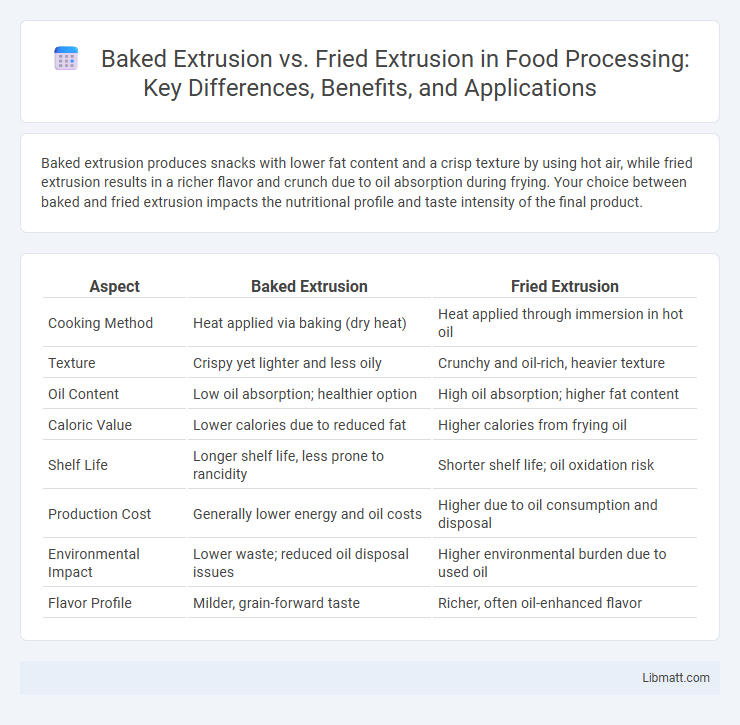Baked extrusion produces snacks with lower fat content and a crisp texture by using hot air, while fried extrusion results in a richer flavor and crunch due to oil absorption during frying. Your choice between baked and fried extrusion impacts the nutritional profile and taste intensity of the final product.
Table of Comparison
| Aspect | Baked Extrusion | Fried Extrusion |
|---|---|---|
| Cooking Method | Heat applied via baking (dry heat) | Heat applied through immersion in hot oil |
| Texture | Crispy yet lighter and less oily | Crunchy and oil-rich, heavier texture |
| Oil Content | Low oil absorption; healthier option | High oil absorption; higher fat content |
| Caloric Value | Lower calories due to reduced fat | Higher calories from frying oil |
| Shelf Life | Longer shelf life, less prone to rancidity | Shorter shelf life; oil oxidation risk |
| Production Cost | Generally lower energy and oil costs | Higher due to oil consumption and disposal |
| Environmental Impact | Lower waste; reduced oil disposal issues | Higher environmental burden due to used oil |
| Flavor Profile | Milder, grain-forward taste | Richer, often oil-enhanced flavor |
Introduction to Baked and Fried Extrusion
Baked extrusion involves cooking ingredients by forcing them through a heated die, resulting in a product with lower fat content and a crunchy texture due to the absence of frying oils. Fried extrusion, on the other hand, subjects the extruded product to hot oil, enhancing its flavor and crispness but increasing calorie count and fat levels. Understanding these differences helps you make informed choices based on texture preferences and dietary considerations.
Process Overview: Baked vs Fried Extrusion
Baked extrusion involves cooking dough or batter by passing it through an extruder and then baking at controlled temperatures, resulting in a product with lower fat content and a crisp texture. Fried extrusion requires the extruded pieces to be submerged in hot oil, producing a crunchy, oil-rich snack with higher calorie content due to oil absorption. Your choice depends on health preferences and desired texture, as baked extrusion offers a healthier alternative while fried extrusion delivers a traditional crispiness.
Key Ingredient Differences
Baked extrusion typically uses lower fat content and incorporates whole grain flours, focusing on moisture removal through heat without oil absorption. Fried extrusion involves higher oil content as the product is submerged in hot oil, resulting in a crispy texture and increased calorie density. Your choice between baked and fried extrusion should consider ingredient composition and health goals due to these key differences.
Nutritional Comparison
Baked extrusion products typically contain lower fat content and fewer calories compared to fried extrusion, making them a healthier option for your diet. Frying extruded snacks increases their oil absorption, which boosts saturated fat and calorie levels, potentially impacting heart health negatively. Choosing baked extrusions can enhance nutrient retention, providing a better balance of proteins, fibers, and micronutrients essential for optimal nutrition.
Texture and Flavor Characteristics
Baked extrusion products exhibit a lighter, crispier texture with a lower oil content, resulting in a toasted, mildly sweet flavor profile. Fried extrusion products have a denser, crunchier texture infused with higher oil levels, enhancing a richer, savory taste and aroma. The choice between baking and frying directly influences the mouthfeel and flavor intensity of extruded snacks.
Production Efficiency and Costs
Baked extrusion offers higher production efficiency due to lower energy consumption and reduced processing times compared to fried extrusion, which requires significant oil heating and longer frying durations. The cost of baked extrusion is generally lower, driven by decreased oil usage, less waste management, and simplified equipment maintenance. Fried extrusion incurs higher operational expenses from oil procurement, frequent filtration, and potential environmental regulations related to oil disposal.
Health and Wellness Implications
Baked extrusion products typically contain lower levels of fat and calories compared to fried extrusion, promoting better cardiovascular health and weight management. Fried extrusion often involves oil absorption that increases saturated fat content and may contribute to inflammation and chronic diseases. Choosing baked extrusion can support your wellness goals by reducing unhealthy fat intake while still providing a satisfying texture and flavor.
Environmental Impact Assessment
Baked extrusion processes typically consume less energy and produce lower greenhouse gas emissions compared to fried extrusion due to reduced oil usage and shorter cooking times. Fried extrusion generates significant wastewater containing oil residues, increasing the complexity and cost of effluent treatment in environmental impact assessments. Lifecycle analyses often favor baked extrusion for its reduced carbon footprint and minimized environmental pollution risks associated with oil disposal.
Market Trends and Consumer Preferences
Baked extrusion products are experiencing significant market growth due to increasing consumer demand for healthier snack options with lower fat content and fewer calories compared to fried extrusions. Innovations in extrusion technology have enhanced texture and flavor profiles of baked snacks, aligning with trends toward clean-label ingredients and gluten-free diets. Your choice between baked and fried extrusions should consider evolving consumer preferences favoring sustainability, natural ingredients, and better nutritional profiles.
Choosing the Right Extrusion Method
Baked extrusion offers a healthier alternative with lower fat content and reduced acrylamide formation compared to fried extrusion, which typically results in higher oil absorption and a crispier texture. Selecting the appropriate extrusion method depends on the desired product attributes, including moisture content, texture, and nutritional profile. Food manufacturers must consider consumer preferences and regulatory standards when deciding between baked and fried extrusion techniques.
baked extrusion vs fried extrusion Infographic

 libmatt.com
libmatt.com